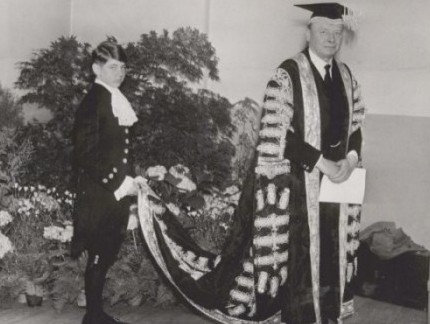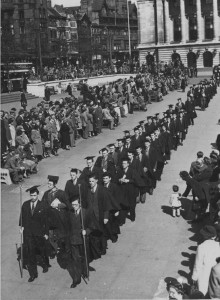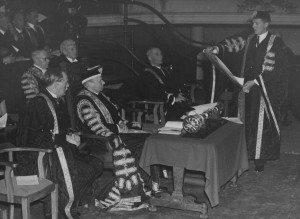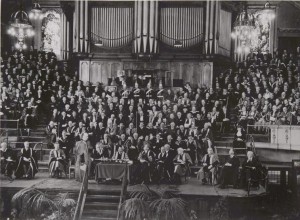
March 12, 2013, by Kathryn Steenson
Nottingham’s New Chancellor
Today Sir Andrew Witty will be installed as only the 7th Chancellor since The University of Nottingham received its Royal Charter in 1948. Here, we look back at the ceremony installing the University’s very first Chancellor.

Procession of students and staff leaving Nottingham Council House, prior to the ceremony installing the first Chancellor of The University of Nottingham. (NMc 6/4)
The role of Chancellor has changed considerably over the last 65 years, becoming less ceremonial and more ambassadorial as universities become increasingly competitive.
The University’s first Chancellor was John Campbell Boot (1889–1956), 2nd Baron Trent. In 1944, four years before it was granted university status, he had been appointed President of its predecessor University College, Nottingham. It was founded in the 1880s as a constituent college of the University of London. Becoming a university in its own right gave it more autonomy, including the power to award its own ‘University of Nottingham’ degrees.
John Campbell Boot was the grandson of John Boot, founder of the pharmacy Boots, and the son of Jesse Boot, who transformed the company into a national business. Jesse Boot was an important benefactor to both the City of Nottingham and the University, and the 2nd Baron Trent carried on the family tradition of philanthropy and maintained the strong ties to the University.
The photographs were taken at his installation as Chancellor on the 3rd May 1949. They come from two different collections: ‘UMP – Photographs from The University of Nottingham and University College, Nottingham’ and ‘NMc – Correspondence of Priscilla McLaren (née Bright, 1815-1906) social reformer, and Sir Henry Norman (1858-1939) journalist, politician and public servant, 1829-1946‘.

Photograph of Vice-Chancellor Bertrand Hallward proclaiming that the Council and Senate have resolved to confer on the Chancellor an honorary degree. (NMc 6/8)

Installation of John Campbell Boot, 2nd Baron Trent, as the 1st Chancellor of the new University of Nottingham, 3 May 1949, in the Albert Hall, Nottingham (UMP/2/2/6/6)
As well as the academic and administrative departments, many of the University’s clubs and societies collect photographs recording their activities, ranging from this type of grand occasion to everyday events. Some were taken by commercial photographers or newspapers, and some by the University’s own photographic unit. Since 1967, photographs and other records have been periodically transferred to Manuscripts and Special Collections. Added to this are photographs and other materials donated to us by former students and staff. These, and other university archives, are available to view in our Reading Room on Kings Meadow Campus.
No comments yet, fill out a comment to be the first

Leave a Reply